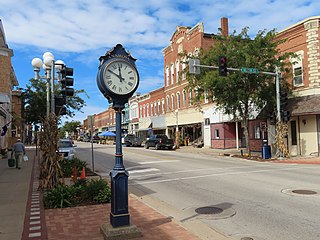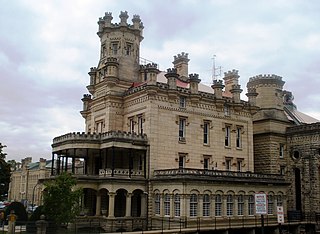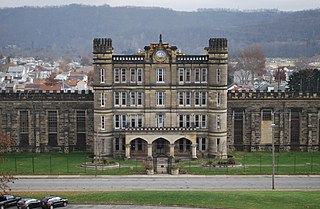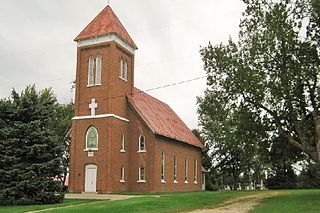
Anamosa is a city in Jones County, Iowa, United States. The population was 5,450 at the 2020 census. It is the county seat of Jones County.
The Iowa State Penitentiary (ISP) is an Iowa Department of Corrections maximum security prison for men located in the Lee County, Iowa, community of Fort Madison. This facility should not be confused with the Historical Iowa State Penitentiary, which was shut down in 2015 after being open for 175 years. The HISP itself was a 550-person maximum security unit. Also on the complex was a John Bennett Correctional Center - a 169-person medium security unit. The HISP included two minimum-security farms with about 170 people who were located within a few miles of the main complex. The complex also had a ten-person multiple care unit, and a 120-bed special-needs unit for prisoners with mental illness or other diseases that require special medical care. In total, there were about 950 inmates and 510 staff members.

Anamosa State Penitentiary is a medium security penitentiary prison located in the Jones County community of Anamosa, Iowa – approximately 25 miles (40 km) northeast of Cedar Rapids, Iowa.

Camp Chase was a military staging and training camp established in Columbus, Ohio in May 1861 after the start of the American Civil War. It also included a large Union-operated prison camp for Confederate prisoners during the American Civil War.

The Lorton Reformatory, also known as the Lorton Correctional Complex, is a former prison complex in Lorton, Virginia, established in 1910 for the District of Columbia, United States.
The Oklahoma State Reformatory is a medium-security facility with some maximum and minimum-security housing for adult male inmates. Located off of State Highway 9 in Granite, Oklahoma, the 10-acre (4.0 ha) facility has a maximum capacity of 1042 inmates. The medium-security area accommodates 799 prisoners, minimum-security area houses roughly 200, and the maximum-security area with about 43 inmates. The prison currently houses approximately 975 prisoners. The prison was established by an act of the legislature in 1909 and constructed through prison labor, housing its first inmate in 1910. The facility is well known for the significant roles women played in its foundation and governance, most notably having the first female warden administer an all-male prison in the nation.

The West Virginia Penitentiary is a gothic-style prison located in Moundsville, West Virginia. Now withdrawn and retired from prison use, it operated from 1866 to 1995. Currently, the site is maintained as a tourist attraction, museum, training facility, and filming location.

The Kentucky State Penitentiary (KSP), also known as the "Castle on the Cumberland," is a maximum security and supermax prison with capacity for 856 prisoners located in Eddyville, Kentucky on Lake Barkley on the Cumberland River, about 4.8 kilometres (3 mi) from downtown Eddyville. It is managed by the Kentucky Department of Corrections. Completed in 1886, it is Kentucky's oldest prison facility and the only commonwealth-owned facility with supermax units. The penitentiary houses Kentucky's male death row inmates and the commonwealth's execution facility. As of 2015 it had approximately 350 staff members and an annual operating budget of $20 million. In most cases, inmates are not sent directly to the penitentiary after sentencing, but are sent there because of violent or disruptive behavior committed in other less secure correctional facilities in the commonwealth. This was Kentucky's second penitentiary: the first was made uninhabitable from a flood in 1937.

The John A. Green Estate is a historic property in Stone City, Iowa, United States. The estate covers 200 acres (0.81 km2) of land. The buildings were constructed of Anamosa Limestone quarried from John Green's own local business. The estate was individually listed as a historic district on the U.S. National Register of Historic Places in 1978. It was included as a contributing property in the Stone City Historic District in 2008.

The Jones County Courthouse in Anamosa, Iowa, United States was built in 1937. It was listed on the National Register of Historic Places in 2003 as the "Jones County Court House." It is a part of the PWA-Era County Courthouses of IA Multiple Properties Submission, and is the third building the county has used for court functions and county administration.

St. Joseph's Catholic Church is a former parish of the Diocese of Davenport. The church is located in Dallas township in rural Marion County, Iowa, United States. It was part of the now defunct village of Bauer. The closest communities are Melcher-Dallas and Lacona. The church building still stands and together with the adjacent cemetery comprises an historic district listed on the National Register of Historic Places.
The British Columbia Penitentiary was a federal maximum security prison located in New Westminster, British Columbia, Canada. The BC Penitentiary operated for 102 years, from 1878 until it was decommissioned in 1980. It was the first federal penal institution west of Manitoba. The Gatehouse was sold on September 8,2021 and was renamed Governors Castle by new owners. Colliers international Appraised the Building at $8,950,000, additional open space for $4,500,00, totalling $13,450,000 at time of purchase by Governors Court Inc.

The Alton Military Prison was a prison located in Alton, Illinois, built in 1833 as the first state penitentiary in Illinois and closed in 1857. During the American Civil War, the prison was reopened in 1862 to accommodate the growing population of Confederate prisoners of war and ceased to be prison at the end of the war in 1865. The prison building was demolished not long after the Civil War. All that remains of the former prison site is a section of ruin wall that is maintained by the State of Illinois as an historic site. The prison site is included in the U.S. National Register of Historic Places.

The South Carolina Penitentiary was the state of South Carolina's first prison. Completed in 1867, the South Carolina Penitentiary served as the primary state prison for nearly 130 years until its demolition in 1999. It was located adjacent to the Congaree River in Columbia, South Carolina and was added to the National Register of Historic Places on January 4, 1996. It was replaced by the Lee Correctional Institution as the main prison in the state of South Carolina after the prison was deemed too overcrowded by a federal court.

Wapsipinicon State Park is located south of Anamosa, Iowa, United States. The 394-acre (159 ha) park is along the sandstone and limestone bluffs of the Wapsipinicon River, from which it derives its name. It is one of the oldest state parks in Iowa, and it was listed as a historic district on the National Register of Historic Places in 2014.

Farm No. 1, Iowa Men's Reformatory, also known as the West Farm, is located west of Anamosa, Iowa, United States. It was listed as a historic district on the National Register of Historic Places in 1992. At the time of its nomination the district consisted of 10 resources, including seven contributing buildings, and three non-contributing buildings. When the property for the reformatory was acquired by the State of Iowa in 1872 it included 61 acres (25 ha) of farmland. Farming at the facility did not become a significant enterprise here until the turn of the 20th century. Before then the prisoners maintained a vegetable garden within the walls, and they raised sixty-five hogs. The state bought 80.31 acres (32.50 ha) of land in 1904 for farming operations and built a hog house and a stone barn, both are no longer extant. Minimum security prisoners did the farm work. The historic buildings were built between 1912 and 1939. They are all stone structures built in a simplified Romanesque Revival style. The influence of the style is found in the "heavy massing, texture of the stone, and the window, door, and corner treatments." The buildings were built for the following uses: South barn, barn granary (1915), root cellar (1919), North barn, slaughter house (1921-1922), processing plant (1922), and the seed house, dining hall, cold frame (1939).
The State Quarry, Iowa Men's Reformatory is a nationally recognized historic district located northwest of Anamosa, Iowa, United States. It was listed on the National Register of Historic Places in 1992. At the time of its nomination the district consisted of five resources, including three contributing buildings, one contributing site, and one contributing structure. This was the second quarry operated by the Anamosa prison. The first was opened in 1872 near Stone City in 1872, and it was exhausted by 1877. They acquired two 40-acre (16 ha) parcels here in 1878 and another the following year. The stone quarried and dressed on site by the prisoners was used to build the prison and sold to other government agencies in the state for their building purposes. None of the stone was placed on the open market. The Chicago and North Western Railroad provided a connection to transport the materials. The last of the usable building stone was quarried in 1915, when they shifted to crushed gravel. The quarry remained in operation until 1943.

The Anamosa Main Street Historic District is a nationally recognized historic district located in Anamosa, Iowa, United States. It was listed on the National Register of Historic Places in 2009. At the time of its nomination the district consisted of 52 resources, including 42 contributing buildings, one contributing structure, and nine non-contributing buildings. The district takes in most of the city's central business district. For the most part, the buildings here were used for commercial purposes, but some of them housed light industrial operations, the post office, and the Masonic lodge. The buildings generally range from one to two stories, but a couple structures are three stories in height. Built between the 1860s and the early decades of the 20th century, the buildings are composed of masonry construction. Several were built using the areas limestone. The Italianate style is dominate, but other late 19th and 20th century revivals, and late 19th and early 20th century American movements are also found here.

The Kentucky State Penitentiary in Frankfort was the first prison built West of the Allegheny Mountains and completed June 22, 1800 when Kentucky was still virtually a wilderness. The Kentucky Legislature of 1798 had appointed Harry Innes, Alexander S. Bullitt, Caleb Wallace, Isaac Shelby and John Coburn as commissioners to choose a location for a “penitentiary house.” The house was described "to be built of brick, or stone, containing cells, workshops, with an outside wall high enough and strong enough to keep the prisoners from getting away." The site chosen was Frankfort, Kentucky. Henry Innis, one of the commission, gave one acre of land and the legislature appropriated $500 towards its building with more funds to be allocated later.


















